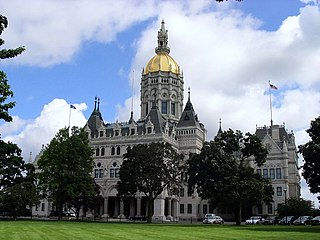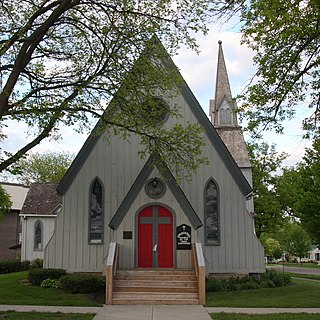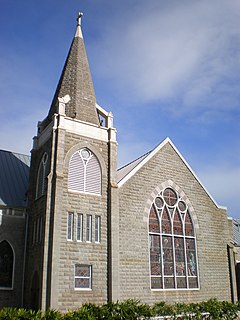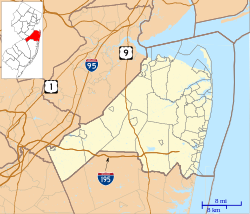
Richard Upjohn was a British-born American architect who emigrated to the United States and became most famous for his Gothic Revival churches. He was partially responsible for launching the movement to such popularity in the United States. Upjohn also did extensive work in and helped to popularize the Italianate style. He was a founder and the first president of the American Institute of Architects. His son, Richard Michell Upjohn, (1828-1903), was also a well-known architect and served as a partner in his continued architectural firm in New York.

William Croswell Doane was the first bishop of the Episcopal Diocese of Albany in the United States. He was bishop from 1869 until his death in 1913.

St. Mary's Episcopal Church is a historic Episcopal parish in Burlington, Burlington County, New Jersey, United States. The original church was built in 1703. It was supplemented with a new church on adjacent land in 1854. On May 31, 1972, the new church was added to the National Register of Historic Places and on June 24, 1986, it was declared a National Historic Landmark. It is within the Burlington Historic District.

Christ Episcopal Church is a historic Episcopal church located at 43 South Broadway in Tarrytown, New York. Topped by a modest tower, the ivy-covered red brick church was built in 1837 and maintains an active congregation to the present day. The church also includes the San Marcos Mission, a Spanish-language ministry.
St. John's Episcopal Church is a historic Episcopal church located at 61 Broad Street in the historic heart of Elizabeth, New Jersey. Now part of the Episcopal Diocese of New Jersey headquartered in Trenton, it was founded in 1706 by missionaries of the Society for the Propagation of the Gospel, London, England. The current building, consecrated in 1860, is in the neo-Gothic style, with a 126-foot Gothic style tower.

St. Peter's Episcopal Church, also known as St. Peter's Church, is located in downtown Albany, New York, United States. It was designed in the mid-19th century by Richard Upjohn and his son Richard M. Upjohn in the French Gothic Revival architectural style. It was listed on the National Register of Historic Places in 1972, and designated a National Historic Landmark eight years later. It is also a contributing property to the Downtown Albany Historic District.
Edward Tuckerman Potter was an American architect best known for designing the 1871 Mark Twain House in Hartford, Connecticut. With his half-brother William Appleton Potter, he also designed Nott Memorial Hall (1858–79) at his alma mater, Union College, Schenectady, New York. Both the Mark Twain House and Nott Memorial Hall are National Historic Landmarks.

The Church of St. James the Less is a historic Episcopal church in Philadelphia, Pennsylvania, that was architecturally influential. As St. James-the-Less Episcopal Church, it was designated a National Historic Landmark for its Gothic Revival architecture, which influenced a generation of subsequent churches.

St. John the Baptist Church is an historic Episcopal church located at 118 High Street in the Sanbornville village of Wakefield, New Hampshire, in the United States. Built 1876–77, it is a prominent regional example of Carpenter Gothic architecture. It was listed on the National Register of Historic Places in 1984. Since January 28, 2007, the Rev. Sue Poulin has been priest-in-charge.

Richard Michell Upjohn, FAIA, was a British-born American architect, co-founder and president of the American Institute of Architects.
The Cathedral of All Saints, Albany, New York, is located on Elk Street in central Albany, New York, United States. It is the central church of the Episcopal Diocese of Albany and the seat of the Episcopal Bishop of Albany. Built in the 1880s in the Gothic style and designed by Robert W. Gibson, it was listed on the National Register of Historic Places in 1974. Previously it had been recognized as a contributing property to the Lafayette Park Historic District, listed on the Register in 1970.

All Saints Anglican Church is a heritage-listed church at 32 Wickham Terrace, Spring Hill, City of Brisbane, Queensland, Australia. First founded in 1862, the current building designed by Benjamin Backhouse was completed in 1869, making it the oldest Anglican church in Brisbane. For most of its history, it has been identified with the High Church or Anglo-Catholic tradition within Anglicanism. It was added to the Queensland Heritage Register on 21 October 1992.

Saint Paul's Church, Chapel, and Parish House are a historic Episcopal Church complex at 15 and 27 Saint Paul Street and 104 Aspinwall Avenue in Brookline, Massachusetts. The Gothic Revival church building was designed by Richard Upjohn and built in 1851-52, and is the oldest surviving religious building in the town. The complex was listed on the National Register of Historic Places in 1985.

St. Peter's Episcopal Church of Peekskill, New York, United States, is located on the north edge of the city's downtown. It is a three-building complex of stone Late Gothic Revival buildings on a half-acre dating to the late 19th century and added onto at successive later dates.

St. Thomas' Episcopal Church is located on Leedsville Road in Amenia Union, New York, United States. It is a mid-19th century brick church designed by Richard Upjohn in the Gothic Revival architectural style, built for a congregation organized shortly before.

Trinity Church is a historic Episcopal congregation located at 33 Mercer Street in Princeton, New Jersey. It is the largest Episcopal church in New Jersey.

St. Barnabas' Episcopal Church, is located in Newark, Essex County, New Jersey, United States. The building was built in 1864 and was added to the National Register of Historic Places on October 18, 1972.

Church of the Good Shepherd Episcopal, a notable example of Rural Gothic architecture located at Moore and 8th Streets in Blue Earth, Minnesota, is the oldest surviving church building in the community. As the congregation diminished in the 1970s regular worship services were eventually suspended; in 1981 its three remaining members donated the building to the Faribault County Historical Society. Since then the church has hosted seasonal ecumenical services, Christmas concerts, weddings, and funerals. It was added to the National Register in 1980.

Christ Church, also known as Christ Episcopal Church, is a Christian house of worship located on the corner of Church Street and Main Street in Newton, New Jersey. It is a parish overseen by the Episcopal Diocese of Newark, a diocese of the Episcopal Church in the United States of America. The congregation first met on 28 December 1769 and was granted a charter by New Jersey's last Royal Governor William Franklin on behalf of Britain's King George III. Christ Church is the oldest church in Newton and the third oldest parish in the Diocese of Newark.

Sacred Heart Church-Punahou is located at 1701 Wilder Avenue, in Honolulu, in the U.S. state of Hawaii. The church was dedicated in 1914, and its adjacent Bachelot Hall was dedicated in 1923. The property's rectory was built in 1927. It was added to the National Register of Historic Places listings on February 6, 2001.



















